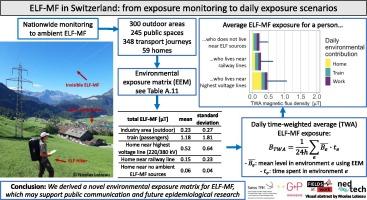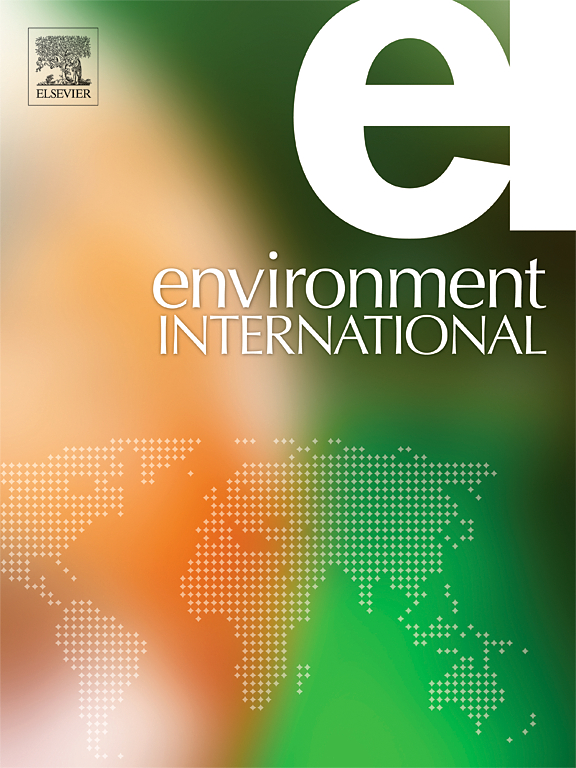Extremely low frequency magnetic fields (ELF-MF) in Switzerland: From exposure monitoring to daily exposure scenarios
IF 9.7
1区 环境科学与生态学
Q1 ENVIRONMENTAL SCIENCES
引用次数: 0
Abstract
Exposure to extremely low frequency magnetic fields (ELF-MF) is ubiquitous in our daily environment. This study aims to provide a comprehensive overview of the ambient ELF-MF exposure in Switzerland and presents a novel environmental exposure matrix for exposure assessment and risk communication. Magnetic flux density levels (µT) were measured using a portable exposimeter carried in a backpack for the main ELF sources: railway power (16.7 Hz), domestic power (50 Hz), and tram ripple current (300 Hz). We collected ELF-MF levels between 2022 and 2024 in various environments representative of the Swiss population: 300 outdoor areas (e.g. city centres, residential areas), 245 public spaces (e.g. train stations, schools), 348 transport journeys (e.g. train, cars), and in 59 homes (e.g. bedrooms, living rooms). Over all environments, the highest ELF-MF exposure levels were measured in train stations (median: 0.48 µT), trains (median: 0.40 µT), and in living rooms near (<200 m) highest voltage lines of 220 kV and 380 kV (median: 0.37 µT). ELF-MF median levels measured two years apart showed high Pearson correlation coefficients in the same 150 outdoor areas (r = 0.88) and 86 public spaces (r = 0.87), without any significant changes. All measurements are well below the Swiss ambient regulatory limit based on the ICNIRP 1998 guidelines (median: 0.2 %). Finally, we derived an environmental exposure matrix and modelled 27 daily time-weighted average ELF-MF exposure scenarios by combining typical time spent at home, work and transport environments. People who do not live near highest voltage lines or work in highly exposed environments are typically exposed to less than 0.3 µT on average, while those who do are likely to exceed this level. This novel environmental exposure matrix is a useful tool for public communication and agent-based exposure modelling for future epidemiological research.


瑞士的极低频磁场(ELF-MF):从暴露监测到日常暴露情景
暴露于极低频磁场(ELF-MF)在我们的日常环境中无处不在。本研究旨在全面概述瑞士的环境ELF-MF暴露,并提出一种用于暴露评估和风险沟通的新型环境暴露矩阵。磁通量密度水平(µT)使用背包中携带的便携式暴露仪测量主要ELF源:铁路电源(16.7 Hz),家庭电源(50 Hz)和电车纹波电流(300 Hz)。我们收集了2022年至2024年间具有瑞士人口代表性的各种环境中的ELF-MF水平:300个户外区域(如城市中心,住宅区),245个公共空间(如火车站,学校),348个交通工具(如火车,汽车)和59个家庭(如卧室,客厅)。在所有环境中,在火车站(中位数:0.48µT)、火车(中位数:0.40µT)和靠近(<200 m) 220 kV和380 kV最高电压线(中位数:0.37µT)的客厅中测量到了最高的ELF-MF暴露水平。隔两年测量的ELF-MF中位数水平显示,在相同的150个室外区域(r = 0.88)和86个公共空间(r = 0.87)中,Pearson相关系数很高,没有任何显著变化。根据ICNIRP 1998年指南,所有测量值均远低于瑞士环境监管限值(中位数:0.2 %)。最后,我们推导了一个环境暴露矩阵,并结合在家庭、工作和交通环境中花费的典型时间,对27个每日时间加权平均ELF-MF暴露情景进行了建模。不生活在最高电压线路附近或在高暴露环境中工作的人通常平均暴露于低于0.3 μ T的环境中,而那些暴露在高暴露环境中的人可能会超过这个水平。这种新型的环境暴露矩阵为未来的流行病学研究提供了一种有用的公共交流和基于主体的暴露建模工具。
本文章由计算机程序翻译,如有差异,请以英文原文为准。
求助全文
约1分钟内获得全文
求助全文
来源期刊

Environment International
环境科学-环境科学
CiteScore
21.90
自引率
3.40%
发文量
734
审稿时长
2.8 months
期刊介绍:
Environmental Health publishes manuscripts focusing on critical aspects of environmental and occupational medicine, including studies in toxicology and epidemiology, to illuminate the human health implications of exposure to environmental hazards. The journal adopts an open-access model and practices open peer review.
It caters to scientists and practitioners across all environmental science domains, directly or indirectly impacting human health and well-being. With a commitment to enhancing the prevention of environmentally-related health risks, Environmental Health serves as a public health journal for the community and scientists engaged in matters of public health significance concerning the environment.
 求助内容:
求助内容: 应助结果提醒方式:
应助结果提醒方式:


